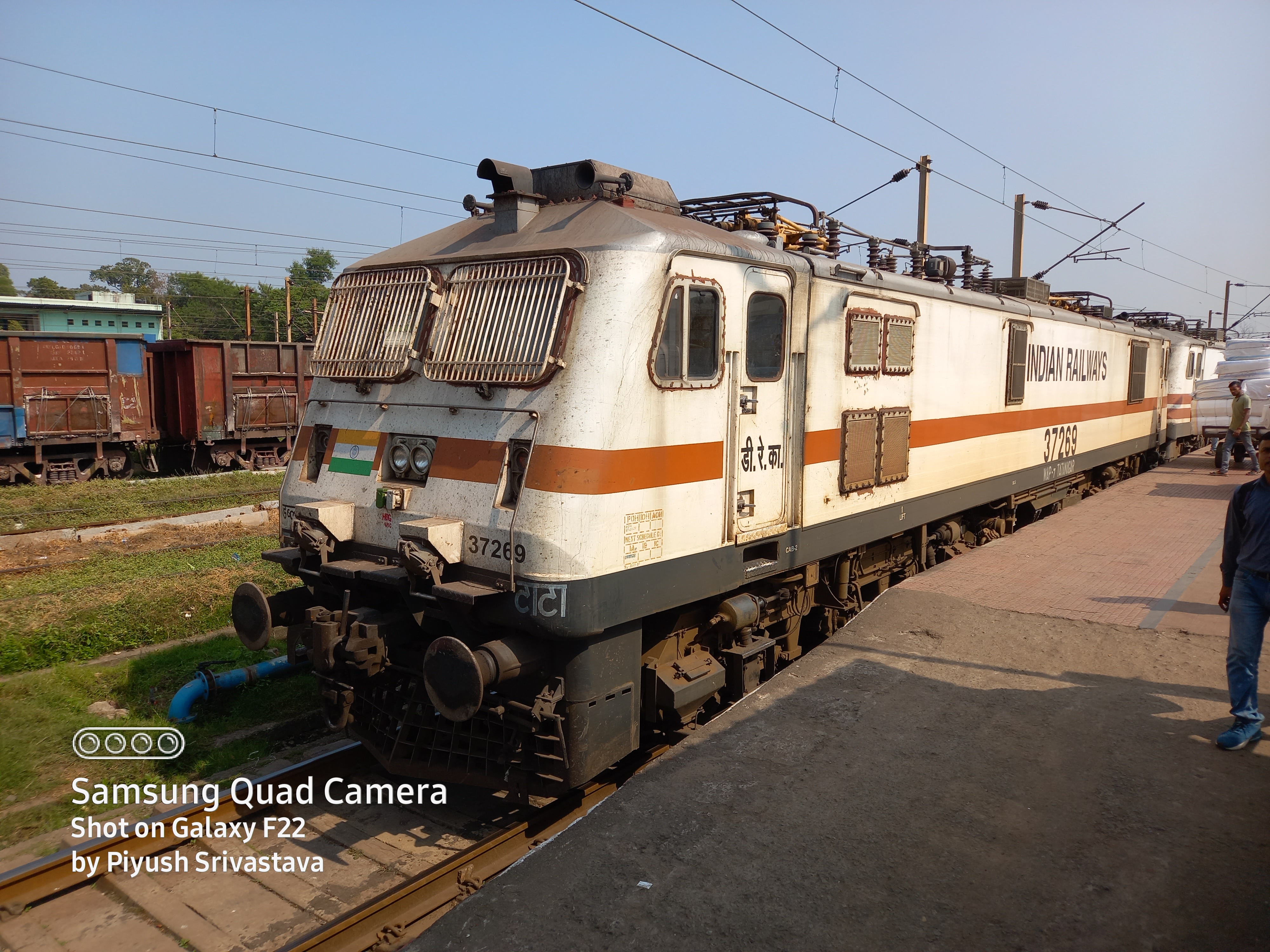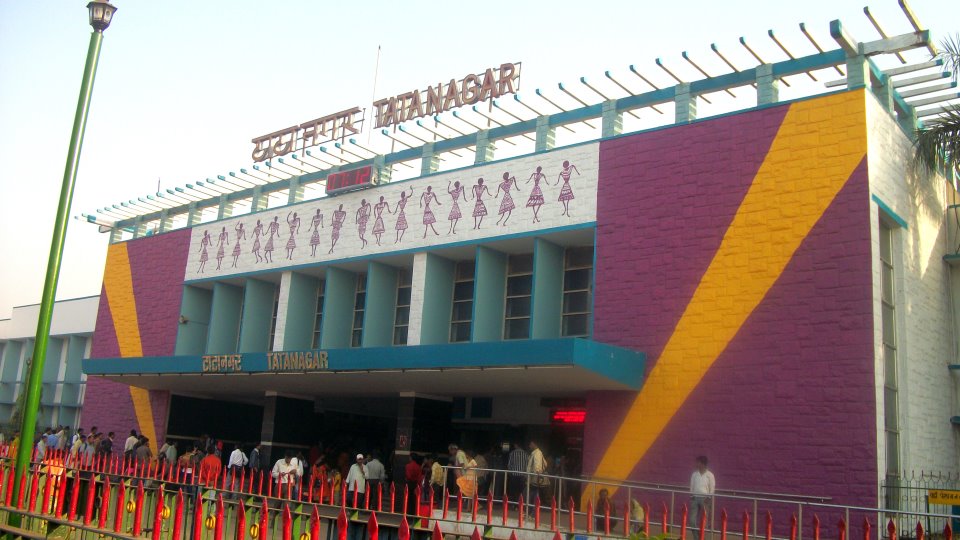|
Electric Loco Shed, Tatanagar
Electric Loco Shed, Tatanagar is a motive power depot performing locomotive maintenance and repair facility for electric locomotives of the Indian Railways, located at Tatanagar of the South Eastern Railway zone in Jharkhand, India. Operations Being one of the three electric engine sheds in South Eastern Railway, various major and minor maintenance schedules of electric locomotives are carried out here. It has the sanctioned capacity of 120 engine units. Beyond the operating capacity, this shed houses a total of 200 engine units, including 27 WAP-7 and 174 WAG-9. Like all locomotive sheds, TATA does regular maintenance, overhaul and repair including painting and washing of locomotives. Livery & Markings TATA based WAP-7 has TATA Steel advertisement on loco's body side. Tatanagar loco shed has its own logo and stencils. It is written on loco's body side as well as front & back side. Locomotives References {{Locomotives Sheds of India Tatanagar Tatanagar Junction ... [...More Info...] [...Related Items...] OR: [Wikipedia] [Google] [Baidu] |
Tatanagar
Tatanagar Junction railway station, station code TATA, is the main railway station serving the city of Jamshedpur in the Indian state of Jharkhand. It is located on the Howrah–Nagpur–Mumbai line of the Indian Railways. It has 6 platforms and handles around 100 trains each day. History The Tatanagar railway station was built in the early twentieth century. Sakchi was identified as the ideal site for an envisaged steel plant in December 1907. In 1910, the village Kalimati which was near Sakchi got itself a railway station on BNR's Howrah–Bombay route. The railway became the lifeline of the steel plant established by the Tatas. The name of the railway station was later changed to Tatanagar in honour of its founder Jamsetji Tata. Tatanagar–Rourkela section was the second 25 kV AC electrified section of the country, the first being Burdwan-Mughalsarai (in 1957). The Tatanagar railway station was built by Nanji Govindji Taunk and his son Ranchhod Nanji Taunk of ''Nanji Govi ... [...More Info...] [...Related Items...] OR: [Wikipedia] [Google] [Baidu] |
Indian Locomotive Class WAG-5
The Indian locomotive class WAG-5 is a class of 25 kV AC electric locomotives that was developed in 1978 by Chittaranjan Locomotive Works for Indian Railways. The model name stands for broad gauge (W), alternating current (A), goods traffic (G) engine, 5th generation (5). They entered service in 1980. A total of 1196 WAG-5 were built at CLW and BHEL between 1978 and 1998, which made them the most numerous class of mainline electric locomotive till its successor the WAG-7. The WAG-5 is one of the most successful locomotives of Indian Railways currently serving both freight and passenger trains for over 42 years. This class provided the basic design for a number of other locomotives, like WAG-7 and the WCM-6. However, with the advent of new 3-phase locomotives like WAG-9 and WAG-12, the WAG-5 locomotives were relegated to hauling smaller passenger trains and now the aging fleet the WAG-5 locomotives are rapidly being withdrawn from mainline duties and scrapped. History W ... [...More Info...] [...Related Items...] OR: [Wikipedia] [Google] [Baidu] |
Jamshedpur
Jamshedpur (, ) or Tatanagar is the largest and most populous city in Jharkhand and the first planned industrial city in India. It is a Notified Area Council and Municipal Corporation and also the headquarter of the East Singhbhum district. It is a popular tourist destination known for its forests, ancient temples and royal palaces. It was ranked as the cleanest city of India in the year 2019. It was founded by Jamsetji Tata, founder of the Tata Group, and was named after him. It was established in 1919. Jamshedpur was ranked as the cleanest city of India in 2020 by Swach Survekshan in 2020. Jamshedpur was ranked the 7th cleanest city of India in 2010. The city is also ranked as 2nd in India in terms of quality of life. Jamshedpur is the 84th fastest growing city in the world according to City Mayors Foundation. It is the headquarters of the East Singhbhum district of Jharkhand and is the 36th – largest urban agglomeration and 72nd largest city in India by population. ... [...More Info...] [...Related Items...] OR: [Wikipedia] [Google] [Baidu] |
Electric Railway Depots In India
Electricity is the set of physical phenomena associated with the presence and motion of matter that has a property of electric charge. Electricity is related to magnetism, both being part of the phenomenon of electromagnetism, as described by Maxwell's equations. Various common phenomena are related to electricity, including lightning, static electricity, electric heating, electric discharges and many others. The presence of an electric charge, which can be either positive or negative, produces an electric field. The movement of electric charges is an electric current and produces a magnetic field. When a charge is placed in a location with a non-zero electric field, a force will act on it. The magnitude of this force is given by Coulomb's law. If the charge moves, the electric field would be doing work on the electric charge. Thus we can speak of electric potential at a certain point in space, which is equal to the work done by an external agent in carrying a unit of positi ... [...More Info...] [...Related Items...] OR: [Wikipedia] [Google] [Baidu] |
Tatanagar WAP 7 37269
Tatanagar Junction railway station, station code TATA, is the main railway station serving the city of Jamshedpur in the Indian state of Jharkhand. It is located on the Howrah–Nagpur–Mumbai line of the Indian Railways. It has 6 platforms and handles around 100 trains each day. History The Tatanagar railway station was built in the early twentieth century. Sakchi was identified as the ideal site for an envisaged steel plant in December 1907. In 1910, the village Kalimati which was near Sakchi got itself a railway station on BNR's Howrah–Bombay route. The railway became the lifeline of the steel plant established by the Tatas. The name of the railway station was later changed to Tatanagar in honour of its founder Jamsetji Tata. Tatanagar–Rourkela section was the second 25 kV AC electrified section of the country, the first being Burdwan-Mughalsarai (in 1957). The Tatanagar railway station was built by Nanji Govindji Taunk and his son Ranchhod Nanji Taunk of ''Nanji Gov ... [...More Info...] [...Related Items...] OR: [Wikipedia] [Google] [Baidu] |
Electric Locomotive
An electric locomotive is a locomotive powered by electricity from overhead lines, a third rail or on-board energy storage such as a battery or a supercapacitor. Locomotives with on-board fuelled prime movers, such as diesel engines or gas turbines, are classed as diesel-electric or gas turbine-electric and not as electric locomotives, because the electric generator/motor combination serves only as a power transmission system. Electric locomotives benefit from the high efficiency of electric motors, often above 90% (not including the inefficiency of generating the electricity). Additional efficiency can be gained from regenerative braking, which allows kinetic energy to be recovered during braking to put power back on the line. Newer electric locomotives use AC motor-inverter drive systems that provide for regenerative braking. Electric locomotives are quiet compared to diesel locomotives since there is no engine and exhaust noise and less mechanical noise. The lack of ... [...More Info...] [...Related Items...] OR: [Wikipedia] [Google] [Baidu] |
Motive Power Depot
The motive power depot (MPD) or locomotive depot, or traction maintenance depot (TMD), is the place where locomotives are usually housed, repaired and maintained when not being used. They were originally known as "running sheds", "engine sheds" or, for short, just sheds. Facilities are provided for refuelling and replenishing water, lubricating oil and grease and, for steam engines, disposal of the ash. There are often workshops for day to day repairs and maintenance, although locomotive building and major overhauls are usually carried out in the locomotive works. (Note: In American English, the term ''depot'' is used to refer to passenger stations or goods (freight) facilities and not to vehicle maintenance facilities.) German practice The equivalent of such depots in German-speaking countries is the '' Bahnbetriebswerk'' or ''Bw'' which has similar functions, with major repairs and overhauls being carried out at '' Ausbesserungswerke''. The number of these reduced dra ... [...More Info...] [...Related Items...] OR: [Wikipedia] [Google] [Baidu] |
Indian Locomotive Class WAP-4
The Indian locomotive class WAP-4 is a class of 25 kV AC electric locomotives that was developed in 1993 by Chittaranjan Locomotive Works for Indian Railways. The model name stands for broad gauge (W), AC Current (A), Passenger traffic (P) engine, 4th generation (4). They entered service in late 1994. A total of 778 WAP-4 were built at CLW between 1993 and 2015, which made them the most numerous class of mainline electric passenger locomotive until the WAP-7. The WAP-4 is one of the most successful locomotives of Indian Railways serving both passenger and freight trains for over 28 years. This class provided the basic design for other locomotives like the WAP-6 . Despite the introduction of more modern types of locomotives like WAP-7, a significant number are still in use, both in mainline duties. Production of this class was halted in December 2015 with locomotive number 25051 being the last unit to be rolled out. As of September 2022, all locomotives except those lost ... [...More Info...] [...Related Items...] OR: [Wikipedia] [Google] [Baidu] |
Indian Locomotive Class WAG-7
The Indian locomotive class WAG-7 is a class of 25 kV AC electric locomotives that was developed in 1990 by Chittaranjan Locomotive Works for Indian Railways. The model name stands for broad gauge (W), alternating current (A), goods traffic (G) engine, 7th generation (7). They entered service in 1992. A total of 1970 WAG-7 were built at CLW and BHEL between 1990 and 2015, which made them the most numerous class of mainline electric locomotive till its successor the WAG-9. The WAG-7 is one of the most successful locomotives of Indian Railways currently serving both freight and passenger trains for over 30 years. Even though with the advent of new 3-phase locomotives like WAG-9 and WAG-12, all WAG-7 locomotives except ones destroyed in accidents, rest are in service and doing all types of duties. History The history of WAG-7 begins in the early 1990s with the aim of addressing the shortcomings of the previous WAG-5 class and remove steam locomotives from IR by a target da ... [...More Info...] [...Related Items...] OR: [Wikipedia] [Google] [Baidu] |
Jharkhand
Jharkhand (; ; ) is a state in eastern India. The state shares its border with the states of West Bengal to the east, Chhattisgarh to the west, Uttar Pradesh to the northwest, Bihar to the north and Odisha to the south. It has an area of . It is the 15th largest state by area, and the 14th largest by population. Hindi is the official language of the state. The city of Ranchi is its capital and Dumka its sub-capital. The state is known for its waterfalls, hills and holy places; Baidyanath Dham, Parasnath, Dewri and Rajrappa are major religious sites. The state was formed on 15 November 2000, after carving out what was previously the southern half of Bihar. Jharkhand suffers from what is sometimes termed a resource curse: it accounts for more than 40% of the mineral resources of India, but 39.1% of its population is below the poverty line and 19.6% of children under five years of age are malnourished. Jharkhand is primarily rural, with about 24% of its population livi ... [...More Info...] [...Related Items...] OR: [Wikipedia] [Google] [Baidu] |
WAM-4
The Indian locomotive class WAM-4 is a class of 25 kV AC electric locomotives that was developed in 1970 by Chittaranjan Locomotive Works for Indian Railways. The model name stands for broad gauge (W), alternating current (A), mixed traffic (M) engine, 4th generation (4). They entered service in March 1971. A total of 500 WAM-4 were built at CLW between 1970 and 1983, which made them the most numerous class of mainline electric locomotive till its successor the WAG-5. The WAM-4 is one of the most successful locomotives of Indian Railways having served both passenger and freight trains for over 52 years. This class provided the basic design for a number of other locomotives like WCAM-1, WAG-5A, WCG-2, and some WAP-1 models. However, with the advent of new 3-phase locomotives like WAP-5 and WAP-7, the WAM-4 locomotives were relegated to hauling smaller passenger trains and most of the units have been scrapped. A few units are in service performing inferior duties. Hist ... [...More Info...] [...Related Items...] OR: [Wikipedia] [Google] [Baidu] |
WAG-9
The Indian locomotive class WAG-9 is a class of 25 kV AC electric locomotives that was developed in 1995 by ABB Group (ABB) for Indian Railways. The model name stands for broad gauge (W), AC Current (A), Goods traffic (G), 9th generation (9) locomotive. They entered service in 1996. A total of 3651 WAG-9 have been built at Chittaranjan Locomotive Works (CLW), with more units being built at Banaras Locomotive Works (BLW), Bharat Heavy Electricals Limited (BHEL) and Patiala Locomotive Works (PLW). It was the most powerful freight locomotive of its fleet until the formal introduction of the WAG-12. The WAG-9 is one of the most successful locomotives of Indian Railways serving freight trains for over 26 years. A passenger variant of the WAG-9 was developed namely the WAP-7 locomotive by modifying the gear ratio to pull lighter loads at higher speeds. Nowadays, It is a common locomotive used in freight trains. Introduction The WAG-9 locomotive is referred to as the "Heavy H ... [...More Info...] [...Related Items...] OR: [Wikipedia] [Google] [Baidu] |






